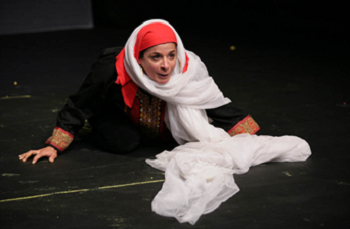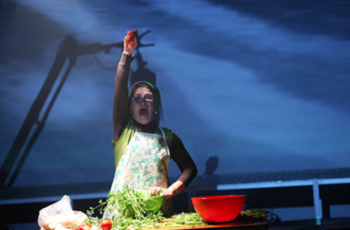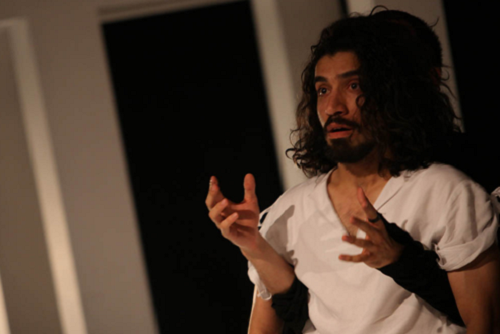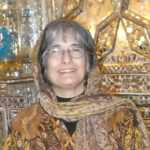Maria Helena Serôdio[1]

On writing about the “28th Fadjr International Theatre Festival” that took place in Tehran (Iran) between the 22ndand 31st of January (2010), one should first point to the political relevance that is inherent in the name itself (the celebration of the “Victory” (Fadjr) of the Islamic Revolution in 1979). Equally significant, perhaps, is the fact that the festival seeks an international visibility for Iranian theatre by claiming (and making it possible) to be international at various levels. It is, therefore, natural that – for better or worse – its display and reception should blend both purposes and, therefore, arouse a certain discomfort among those who may be more critical of the present political situation in Iran; one of the most prominent (international) reactions was the withdrawal of a performance directed by Peter Brook, the monologue The Grand Inquisitor, based on Dostoyevsky’s The Brothers Karamazov, featuring Bruce Meyers.
It was, nevertheless, an important showcase for many theatre companies that could not only show their performance(s) live (if they had been selected for the festival), but also use the Arts Market (at the Vahdat Hall) to meet critics and audience members alike and offer DVDs and other material of their own performances. And that proved to be a very important step for them to present their own history, repertoire and aesthetics; this possibility was open even to some companies who were not showing any performance at the festival. Moreover a book was launched on Theatre in Iran 2010 (written by Mohammad Atebbai) and a journal (quite interesting in its layout and photos) was offered on a daily basis with information on the theatrical events that were taking place throughout the festival, thus turning out to be important sources for learning about theatre being made in Iran.
The festival used 15 venues (in some cases they were different halls of the same theatre venue), besides some open air performances, and involved the presentation of over a hundred productions, mainly Iranian, but some coming from other countries as “international guests”: as was the case with theatre companies coming from China, South Korea, Italy, Greece, Turkey, Russia, Venezuela and Colombia among others. The international status of the festival was also attested by the invitation extended to critics and practitioners from foreign countries to be members of juries or to give lectures and workshops under the auspices of the festival.
Attended by large audiences, the performances were distributed among different categories as ‘International competition’, ‘Iranian theatre panorama 2010’, ‘New experiences’, ‘Best of regional festivals’ and ‘Theatre of Nations’, among other groups of participating productions. The IATC jury, invited mainly to attend and evaluate the ‘Iranian theatre panorama 2010’ (but also some other performances under the label of “New Experiences”), was the first such jury invited to the festival; it included Yun-Cheol Kim, Ian Herbert, Mehrdi Nasirikhah, Mehrdad Rayani Makhsus and myself.
Katy Salmasi, Member of the Executive Committee of the IATC and President of the Iranian Association of Theatre Critics, was a most helpful hostess to the jury, and, in general, everything related to the festival was extremely well organised by the secretariat of the Dramatic Arts Centre, which was responsible for the whole event.
History revisited
Some of the performances we saw were based upon historical facts, which were sometimes relatively recent. Others went as far (and wide) as blending history and myth. On reflection, some of the productions seem lacking in artistry, even if they were inspired by good intentions in addressing important issues of violence, destruction and death. Others evoked a deeper understanding of humanity’s travails by stressing dramatic choices and showing the painful consequences of many of the struggles within and beyond Iran.
Amir Rezamir’s play Now to the East (dir. Reza Khodadbeygi) looked back to the Tartars´ invasion of Iran, while Earth Lying Trilogy (written and directed by Sa’eed Tashakori) was a meditation on genocides and on that human flaw that makes mankind so apt to destroy itself.
Various references to wars and conflicts which have affected life in Iran throughout the past two centuries recalled painful memories, be they regarding the Constitutional Revolution in the 19th century (as was the case of Bride’s Veil, written and directed by Amir Amjad) or the Iraq-Iran war, in the early 1980’s, which inspired both Bitter Acorns (written and directed by Shahram Karami) and Jesus’ Leap Year(written by Nader Sa’eevar and directed by Yaqub Sediq Jamali). In this latter performance a woman (daughter of a priest) receives a little baby boy to take him to a safe place after a bomb attack, but cannot resist the “temptation” to adopt him in a very informal way, never admitting that he was not her real son. The action shows how twenty years later she is going to reveal that truth to the young man.Bitter Acorns was more focused on the condition of those who live in small villages near the border between the two countries and have to survive amid constant raids, always on the verge of losing friends and relatives, or feeling forsaken by those who just pass by, unaware of the need for love, peace and stability. Some interesting (though simple) scenic devices used the condition of the woman, who was a carpet weaver, by constantly ravelling threads of wool, and the actress playing the young woman (who appears to have a slight learning disability) brought a tenderness to the sad life that was being portrayed.

Bride’s Veil (that was awarded the Prize for Best Play by the IATC jury) was a complex story located at the time of the assault of the Mojahedin constitutionalists upon the Qajar dynasty, which was considered to be acting against the patriotic national interest. The veil (or chador) that is being prepared for the bride can be seen both as a token designed to bring happiness, and as a way to disguise under anonymity, a possibility which is always inherent within the use of a chadoror burqa. Although set against this historical background, and significant in its commentary upon its historical circumstances, this story of the veil also offered the possibility of beautiful visual compositions on stage, bringing to our minds the atmosphere of a feminine domestic interior that might evoke Federico Garcia Lorca’s 1930s trilogy on women (Blood Wedding, Yerma and The House of Bernarda Alba). This was the case with a chorus of six women dressed in black (later in red), with white veils covering their faces, who are seated facing the audience with closed doors at their backs; this tableau – in addition to the presence of a sewing machine, and the sewing of the veil – creates the framework for the “raids” of Cossacks, revolutionaries, treasons and punishments.
If a performance like The Last Supper (by Mohammad Reza Kuhestani, directed by Ahmad Soleymani) presented war in a low key (managing to use junk to build an improbable ‘handmade’ set for the ‘war’), General Swords (by Ghodrat Fat’hi, directed by Massoud Moussavi) evoked the Second World War with the tint of a detective thriller: a group of Iranian men, which is engaged in resistance to the German army, is betrayed by one of their number, leading to the execution of 10 of them (only two survive). Twenty years later they meet again to clarify who was to blame.
Entrance Nº 5 (written and directed by Rasoul Naqavi) elaborated on a complex story about a young boy who disobeyed the authorities. The Scarecrow of Jinni Valley (written and directed by Mohammad Hadi Namvar) was based on a folkloric tale about love forbidden by the girl’s father, which, set in a rural environment, allowed for Iranian folk songs and deliberately naïve and romantic sets.


Spiritual longings
Based on Mulla Sadra’s biography (c. 1571–1636) Hundred Roads to Sadra (written and directed by Azim Musavi) evoked the life and thought of this important Iranian philosopher in a most comprehensive saga, involving many actors and giving expression to various episodes and different atmospheres. Infused by an idea of a long physical and spiritual peregrination, the performance allowed for interesting―sometimes funny, sometimes dramatic―sketches, served by a pleasing music (composed by Majid Derakshani and played live) which engaged the audience throughout. Expressed by means of the performative aesthetics of Iranian ritual theatre (Tazieh) and traditional plays (takht-i-howzi), the performance used satire to narrate the many vicissitudes of the philosopher’s life, ending with a mystical dance (Sama).
Actress―Sima Tirandaz―playing Parikhani-e Love and Stone (written and directed by Chista Yasrebi) displayed the inner struggle of an infidel woman who is moved to follow Prophet Mohammad’s religion by sheer devotion, even in the face of the animosity of her family. Despite facing adversity and doubt, she learns through His message of Love and Mercy to believe in Humanity and Love. Her moving interpretation amply justified the Award for Best Actress granted to Tirandaz by the IATC jury, which also awarded the Prize for Best Music to the composers and musicians of this performance: Ebrahim Tusi and Meysam Javadi.
Two other performances were incursions into a kind of nightmarish dimension that revealed personal inabilities and fears: 11: 11 (by Hasan Barzegar, directed by Roksana Bahram) and Zero o’clock (written, directed and with stage design of Attila Pessyani). The former showed a man fighting in his sleep with images of pigeons clashing on his windows or of his wife joining his psychiatrist to perform surgery to him (by pulling his heart out).Other extravagant dreams assaulted him by bringing Venetian masks and robes as sensual pleasures that could evoke either the aura of The Arabian Nights or of the mysterious castle in Stanley Kubrick’s Eyes Wide Shut.
In Attila Pessyani’s world we enter a more elaborate fantasy, one which might remind us of Edgar Allan Poe’s mysterious and grim universe just as it showcases sophisticated sound effects and engaging atmospherics: as if fear and desire were stepping into a pulsing heart. Performed by Pessyani himself, this was a most baffling way of learning―directly and thoroughly―about this Iranian playwright, who had two other plays being performed at the festival and has already secured quite an international reputation.
Fictional worlds and assessment of real life

Written and directed by Simin Amiriyan,Amber was an intricate story involving three students of literature, two elderly men, one young woman―who lives with a dominant mother―and a jar with “poisonous” jam. A sequence of sketches with possible overlapping of the same characters in different times seemed to testify how the imagination has power to create secondary worlds as ‘true’ as life itself.

Two other performances seemed to resort to the same meditation on the possible worlds engendered by literature: The Bell Jar(written and directed by Taniya Mir Motahari) and Arghavan (by Malihe Moradi Jafari, directed by Ahmad Tranikhah). While the former evoked poet Sylvia Plath through her daughter’s memories, the latter brought about a curious plot in which a woman, Arghavan, claims that a novelist (married to a costume designer) had written a novel that coincides absolutely with her private life in its most secret details. Could it be just the power of imagining the real, or could it be the result of a spying technique? The final revelation that he has just finished a novel which reveals what Arghavan is going to do in the near future only serves to strengthen this suspicion even further.
Focusing on family ties, two productions portrayed a crisis and presented different outcomes: these were God Talks in Altona (by Mohammad Ebrahimian, dir. Massoud Delkhah) and Time-Place-Subject, written and directed by Saeed Alboebadi. The former speaks of a man who had sent his son to Germany during the war to spare him any danger, but when visiting him 15 years later realises that it is no longer possible for them to understand each other. For his energetic and moving interpretation, actor Behzad Farahani―who played the old father who dies at the railway station of Altona in Hamburg by sheer regret―was awarded the Prize for Best Actor by the IATC jury.
Time-Place-Subject spoke of a young couple about to divorce and of their teenage daughter learning how to overcome that sorrow. She had met at the park a young woman who had cancer and who had learned to live with her suffering by imagining a happy love relationship, thus sustaining the life which can be created through imagination.


Transfiguring life and drama
Three other performances further attested to the high quality of Iranian theatre, arousing great enthusiasm among audiences and critics alike. Two of them were based on Atilla Pessyani’s plays―Unravelling on a Silent Feast and Garden of Death―while Othello, by Shakespeare, inspired a wonderful dance/ theatre performance directed by choreographer Atefeh Tehrani, director of the recent Indra company (who deservedly received the Prize for Best Director). Indeed, despite the difficulty in staging dance and the prohibitions surrounding touching between men and women within Iranian theatre, the latter production was a wonderfully ingenious and moving re-enactment of Shakespeare’s play which seemed to go beyond all obstacles in order to fashion a world of passion and grief. The costumes, designed by Sahar Efekharadeh (who justly received the Prize for Best Costumes), were fascinating and the choreography manifested not only a strong idea of characters and actions, but also the prodigious physical preparation of the dancers. What a fabulous lesson in theatre and dance!

Shakespeare again would enter this Festival to let Pessyani invent in The Garden of Death a funny character of a theatre director who wants so much to stage Macbeth that he buys a theatre venue to do so, but is torn by his three wives since each of them wants to play Lady Macbeth. Directed by Siyamak Ehsa’i, the presentation showed creative spaces and funny skirmishes among actresses, thereby depicting rivalries and dreams of glory that seem to affect theatre life, as well as the will to live through the fortunes and misfortunes of fictional characters.
As for the Prize for Best Performance: it went to Unravelling on a Silent Feast, directed by Reza Hadad. Based on an idea of young people preparing for a party, the performance was made up of sketches that presented each of them with his/her own sadness, discomfort and ennui; be it a woman working in the kitchen, or longing to achieve beauty at the hairdresser. It was a lively show, with much music, technical effects achieved via screen projections, which, above all, was infused with an affecting commentary on lives on the verge of despair.
This 28th Fadjr International Theatre Festival showed, indeed, a great amount of theatre in the making, different in perspective, various in aesthetics and with distinct artistic possibilities. But it is true that a great proficiency, interesting ideas and moving experiences were waiting for us on Tehran stages, thus testifying to a great vitality among Iranian theatre people.




[1] Maria Helena Serôdio is President of the Portuguese Association of Theatre Critics (APCT), Honorary General Secretary of the IATC, and Director of the Portuguese theatre journal Sinais de Cena. At the University of Lisbon, she directs the Graduate course (Master and PhD) on Theatre Studies and is a senior researcher at the Centre for Theatre Studies where she directs two national research projects. She has published (and edited) several books on theatre.
Copyright © 2009 Maria Helena Serôdio
Critical Stages/Scènes critiques e-ISSN: 2409-7411
This work is licensed under the
Creative Commons Attribution International License CC BY-NC-ND 4.0.
